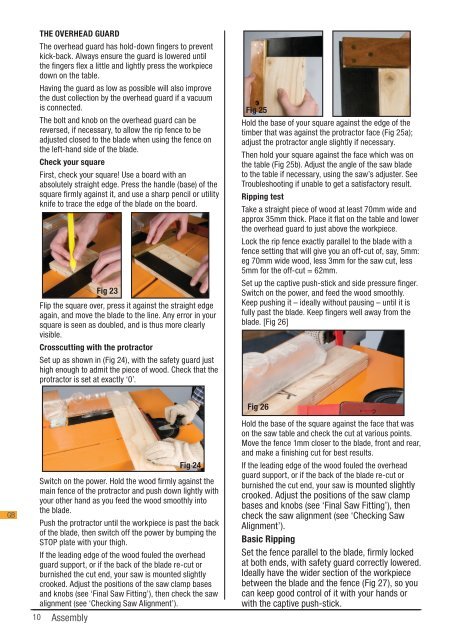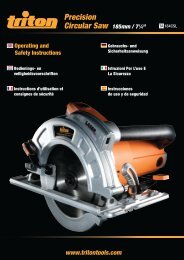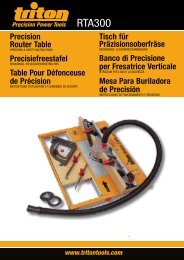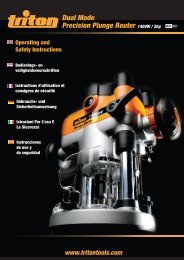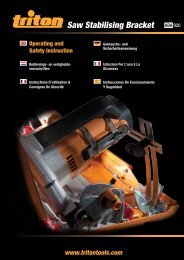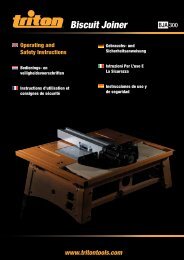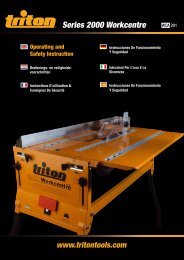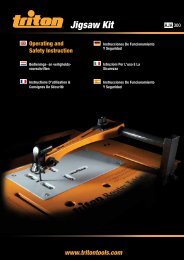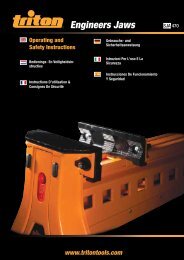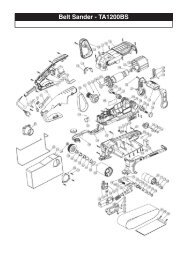Manual de instrucciones - Triton Tools
Manual de instrucciones - Triton Tools
Manual de instrucciones - Triton Tools
You also want an ePaper? Increase the reach of your titles
YUMPU automatically turns print PDFs into web optimized ePapers that Google loves.
THE OVERHEAD GUARD<br />
The overhead guard has hold-down fingers to prevent<br />
kick-back. Always ensure the guard is lowered until<br />
the fingers flex a little and lightly press the workpiece<br />
down on the table.<br />
Having the guard as low as possible will also improve<br />
the dust collection by the overhead guard if a vacuum<br />
is connected.<br />
The bolt and knob on the overhead guard can be<br />
reversed, if necessary, to allow the rip fence to be<br />
adjusted closed to the bla<strong>de</strong> when using the fence on<br />
the left-hand si<strong>de</strong> of the bla<strong>de</strong>.<br />
Check your square<br />
First, check your square! Use a board with an<br />
absolutely straight edge. Press the handle (base) of the<br />
square firmly against it, and use a sharp pencil or utility<br />
knife to trace the edge of the bla<strong>de</strong> on the board.<br />
Fig 23<br />
Flip the square over, press it against the straight edge<br />
again, and move the bla<strong>de</strong> to the line. Any error in your<br />
square is seen as doubled, and is thus more clearly<br />
visible.<br />
Crosscutting with the protractor<br />
Set up as shown in (Fig 24), with the safety guard just<br />
high enough to admit the piece of wood. Check that the<br />
protractor is set at exactly ‘0’.<br />
Fig 25<br />
Hold the base of your square against the edge of the<br />
timber that was against the protractor face (Fig 25a);<br />
adjust the protractor angle slightly if necessary.<br />
Then hold your square against the face which was on<br />
the table (Fig 25b). Adjust the angle of the saw bla<strong>de</strong><br />
to the table if necessary, using the saw’s adjuster. See<br />
Troubleshooting if unable to get a satisfactory result.<br />
Ripping test<br />
Take a straight piece of wood at least 70mm wi<strong>de</strong> and<br />
approx 35mm thick. Place it flat on the table and lower<br />
the overhead guard to just above the workpiece.<br />
Lock the rip fence exactly parallel to the bla<strong>de</strong> with a<br />
fence setting that will give you an off-cut of, say, 5mm:<br />
eg 70mm wi<strong>de</strong> wood, less 3mm for the saw cut, less<br />
5mm for the off-cut = 62mm.<br />
Set up the captive push-stick and si<strong>de</strong> pressure finger.<br />
Switch on the power, and feed the wood smoothly.<br />
Keep pushing it – i<strong>de</strong>ally without pausing – until it is<br />
fully past the bla<strong>de</strong>. Keep fingers well away from the<br />
bla<strong>de</strong>. [Fig 26]<br />
GB<br />
10<br />
Fig 24<br />
Switch on the power. Hold the wood firmly against the<br />
main fence of the protractor and push down lightly with<br />
your other hand as you feed the wood smoothly into<br />
the bla<strong>de</strong>.<br />
Push the protractor until the workpiece is past the back<br />
of the bla<strong>de</strong>, then switch off the power by bumping the<br />
STOP plate with your thigh.<br />
If the leading edge of the wood fouled the overhead<br />
guard support, or if the back of the bla<strong>de</strong> re-cut or<br />
burnished the cut end, your saw is mounted slightly<br />
crooked. Adjust the positions of the saw clamp bases<br />
and knobs (see ‘Final Saw Fitting’), then check the saw<br />
alignment (see ‘Checking Saw Alignment’).<br />
Assembly<br />
Fig 26<br />
Hold the base of the square against the face that was<br />
on the saw table and check the cut at various points.<br />
Move the fence 1mm closer to the bla<strong>de</strong>, front and rear,<br />
and make a finishing cut for best results.<br />
If the leading edge of the wood fouled the overhead<br />
guard support, or if the back of the bla<strong>de</strong> re-cut or<br />
burnished the cut end, your saw is mounted slightly<br />
crooked. Adjust the positions of the saw clamp<br />
bases and knobs (see ‘Final Saw Fitting’), then<br />
check the saw alignment (see ‘Checking Saw<br />
Alignment’).<br />
Basic Ripping<br />
Set the fence parallel to the bla<strong>de</strong>, firmly locked<br />
at both ends, with safety guard correctly lowered.<br />
I<strong>de</strong>ally have the wi<strong>de</strong>r section of the workpiece<br />
between the bla<strong>de</strong> and the fence (Fig 27), so you<br />
can keep good control of it with your hands or<br />
with the captive push-stick.


